
What about an old 35mm SLR?
by Philip Greenspun; created 1998
Site Home : Photography : What about an old 35mm SLR?

by Philip Greenspun; created 1998
Site Home : Photography : What about an old 35mm SLR?
Does one need a modern SLR? Sometimes it is possible to lose sight of the fact that many folks have perfectly functioning systems from the 1970s. What is it like to step back in time?
For my evaluation, I borrowed a Nikon F2A from Jon Robichaud. The F2A is what a working photojournalist would have had in 1977.
Stepping back 20 years from a modern SLR to the Nikon F2A, you lose the following:
Well, you get the idea. The F2A has a lot of useful features that most modern cameras do not have. There are some who think it is the best camera that Nikon ever made.
The first thing you notice is that the F2A holds your film like a vault. Nobody ever opened up the back of one of these guys by mistake. You turn a beautifully machined flip-out key on the bottom to flip the back open. You pull the leader out and slip it into a take-up spool which has a small grabber for the frame notches. It is the most positive film loading system that I've used on a 35mm camera, not counting modern autoloading systems. If you're completely inexperienced with the camera, this could take you an extra 30 seconds over loading a modern AF SLR.
Old cameras don't have "little windows" in the back so that you can see what kind of film is in there; the F2A has a metal holder for the cardboard edge of a 35mm film box. So if you want to be reminded that you've got Tri-X in there, you just insert the Kodak box top.
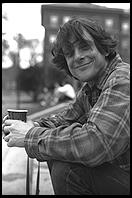 With any 35mm camera,
there are only three settings that affect the picture you get on film: shutter
speed, lens aperture, and focus. The F2A has three easy-to-find wheels to control
these settings. In the DP-11 viewfinder, you can verify that all three are set
correctly. The camera shows you the lens f-stop (optically piped through from the
top of the lens), the shutter speed (mechanically coupled from the shutter speed
dial), and you can see whether or not your image is correctly focussed. A meter
needle with +/- markings shows you whether or not your exposure agrees with the
center-weighted meter's recommendation.
With any 35mm camera,
there are only three settings that affect the picture you get on film: shutter
speed, lens aperture, and focus. The F2A has three easy-to-find wheels to control
these settings. In the DP-11 viewfinder, you can verify that all three are set
correctly. The camera shows you the lens f-stop (optically piped through from the
top of the lens), the shutter speed (mechanically coupled from the shutter speed
dial), and you can see whether or not your image is correctly focussed. A meter
needle with +/- markings shows you whether or not your exposure agrees with the
center-weighted meter's recommendation.
Note: Compare this to my review of the Canon Rebel G in which I discuss the misery that comes from Canon cheaping out and giving you two wheels to control the three important settings.
You turn the meter on and off by pulling the film advance lever out a bit (almost all old Nikons work this way). Oh yes, the film advance lever. You get into the habit of winding the camera after every picture. It takes about one-third of a second.
The camera is heavy but not really bigger than my EOS-5 wonder bodies. It is big enough that you don't need a vertical grip or winder to hold it comfortable horizontally or vertically.
The controls are simple and direct. If you want to use the self-timer, you don't look for icons and leetle buttons, you pull the self-timer down and press the button that is revealed when you do so. If you want 2-seconds, you only pull it to the 2-second mark.
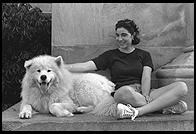 With an F2A and
a 50, here's how you take a picture... You think about how big your subject
should be on film. Because you don't have a zoom lens, you deliberately move your
body back and forth until the subject has the right size in the viewfinder. You
look for something that is close to 18% in tone and in the same light as your
subject. You point the camera at it and set shutter speed/aperture based on
With an F2A and
a 50, here's how you take a picture... You think about how big your subject
should be on film. Because you don't have a zoom lens, you deliberately move your
body back and forth until the subject has the right size in the viewfinder. You
look for something that is close to 18% in tone and in the same light as your
subject. You point the camera at it and set shutter speed/aperture based on
After making these decisions, you try to work with your subject without revisiting them for awhile. You concentrate on the composition, the expression (if your subject is a person or a dog), and maybe bracket your exposure a bit if you want different moods on slide film. You can periodically glance at the meter to make sure that you haven't knocked the exposure way off.
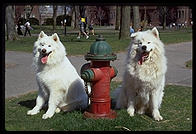 Using flash on an old Nikon F is
absurdly painful. There is no hot shoe on top. In fact, there is no shoe at all.
You generally have to stick an adapter (AS-1) over the rewind knob and plug the
flash into that. You can also use the PC-cord socket, for which there is
mercifully no X/M switch to get stuck on the wrong setting (M for flash bulbs);
this is an easy way to lose pictures with an old camera. Fastest sync speed is
1/80th of a second, so the F2 isn't a great camera for fill-flash.
Using flash on an old Nikon F is
absurdly painful. There is no hot shoe on top. In fact, there is no shoe at all.
You generally have to stick an adapter (AS-1) over the rewind knob and plug the
flash into that. You can also use the PC-cord socket, for which there is
mercifully no X/M switch to get stuck on the wrong setting (M for flash bulbs);
this is an easy way to lose pictures with an old camera. Fastest sync speed is
1/80th of a second, so the F2 isn't a great camera for fill-flash.
Once you've got a Vivitar 283 or similar auto-sensor flash hooked up, how easy is it to use? Trivial. You use a wheel calculator on the flash to determine the correct aperture for your film speed, set the lens to this aperture, and then snap away. What about fill-flash? Just set the calculator wheel on the flash as though you were using faster film (for fill that is 1-stop below ambient when you're using ISO 100 film, tell the flash the you've got ISO 200 film).
How are the results from these old-style flash systems? Many people think that they work better than modern cameras that meter flash exposure through-the-lens. Neither is really as good as the way P&S cameras calculate flash exposure or the way the new Nikon D system works (these get subject distance from the lens and use the fact that the flash is of known power output; they don't rely on light returning from a subject and hence work equally well if the subject is wearing dark or light clothing).
You can make multiple-exposures by simply pressing and holding the film rewind button while advancing the film. When you're done, make a blank exposure with the lens cap on and the camera set to f/16 and 1/2000th. Then wind the film normally (you can watch the rewind knob).
A standard cable release does not work on this camera; you need something special that threads into the shutter release.
Make sure the film is loaded properly by watching the rewind knob as you wind film. The rewind knob should rotate. If it does not, it means that the film slipped off the takeup spool when you were loading the camera. Another way to check this is just to tighten up the film with the rewind knob. You should feel resistance after a few turns.
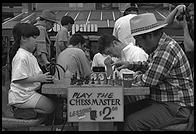 The autowinder
included in a modern camera is simply useless in most situations; after a few
shots, you don't even notice that you're winding film in an F2 (you can attach an
accessory winder if you like, but they are heavy and bulky). The fancy meter
systems in modern cameras are OK, but if you're doing a serious photo project
they aren't of much use. Autofocus is great for sports, dogs playing, etc., but
you can do quite well with an manual focus system if you're willing to pick your
battles carefully. Prefocus and then wait to trip the shutter when the subjects
cross the plane of sharp focus.
The autowinder
included in a modern camera is simply useless in most situations; after a few
shots, you don't even notice that you're winding film in an F2 (you can attach an
accessory winder if you like, but they are heavy and bulky). The fancy meter
systems in modern cameras are OK, but if you're doing a serious photo project
they aren't of much use. Autofocus is great for sports, dogs playing, etc., but
you can do quite well with an manual focus system if you're willing to pick your
battles carefully. Prefocus and then wait to trip the shutter when the subjects
cross the plane of sharp focus.
Prime (i.e., non-zoom) lenses from the 1970s can be of excellent quality. If you have or inherit an extensive manual-focus system, you should get the bodies professionally cleaned and adjusted and then enjoy the system for another decade or two. After that, we'll all probably just be using high-resolution video cameras and picking out interesting still frames.
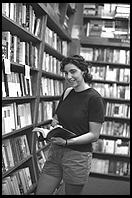 Definitely the best
system to own is Nikon. That's because they haven't changed their lens mount. You
can use all the new lenses on old cameras and old lenses on new cameras. Also,
because Nikon was the market leader among professional photographers, there is a
wide selection of used gear available. The downside of Nikon is that used gear
tends not to be especially cheap. A lot of those old lenses will work fine on the
latest N90 or F5 so why should people dump them?
Definitely the best
system to own is Nikon. That's because they haven't changed their lens mount. You
can use all the new lenses on old cameras and old lenses on new cameras. Also,
because Nikon was the market leader among professional photographers, there is a
wide selection of used gear available. The downside of Nikon is that used gear
tends not to be especially cheap. A lot of those old lenses will work fine on the
latest N90 or F5 so why should people dump them?
A friend of mine worked for National Geographic for many years on assignment in Japan, South America, etc. He used and still uses his Canon FD system. Supposedly the best bodies in this line are the T70 and T90, which have a lot of modern AF body features minus the AF. Old Canon gear can be moderately cheap because none of it works on the EOS system.
The Minolta system was more of a consumer favorite (I think in the early/mid-1970s their SRT-100/101/102 line was the most popular SLR produced). They made some excellent MD lenses, though, and these again can be cheaper than their old Nikon equivalents because MD lenses won't work on Maxxum cameras.
The Olympus OM-1, OM-2, and OM-4 cameras plus Zuiko prime lenses are excellent. Olympus seems to have given up on the SLR system business, but some retailers still have new Olympus MF lenses and bodies to sell.
If you want an F2, try the retailers on my "where to buy" page. eBay works too. Budget at least $150 for each body and $50 for each lens if you are going to have stuff cleaned and adjusted.
a classic 35mm SLR camera system? Brand-new Canon EOS bodies and lenses! I'm short of time and long on money and I can't afford to have a camera or lens fail on me in some subtle mechanical way that doesn't become apparent until 20 rolls of slides come back from the lab. If I drop a body, I want to be able to buy a new one in a medium-size town or have B&H Photo FEDEX me one.
Does that mean I don't have any mechanical cameras? Sure I do but they are mostly weird medium and large-format items such as a Fuji 617 camera and a Linhof Master Technika.
The photos on this page are all from two test rolls that I burned with the F2AS that John lent me. For authenticity, I put a roll of Tri-X through the camera. To test the 50/1.4's color rendition, I used a roll of modern slide film: Kodak Elite 100. The images shown were the best of the lot.